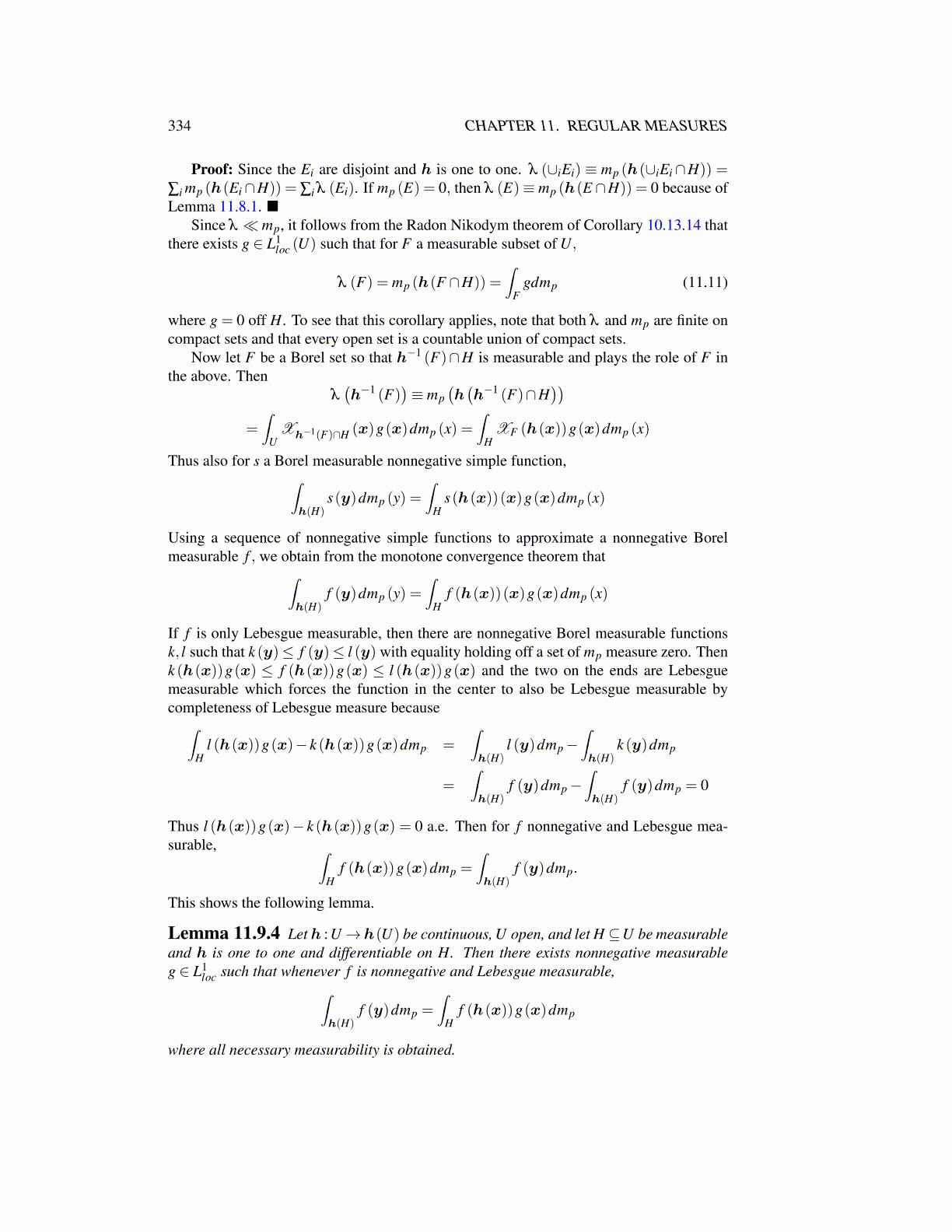
334 CHAPTER 11. REGULAR MEASURES
Proof: Since the Ei are disjoint and h is one to one. λ (∪iEi) ≡ mp (h(∪iEi∩H)) =
∑i mp (h(Ei∩H)) = ∑i λ (Ei). If mp (E) = 0, then λ (E)≡mp (h(E ∩H)) = 0 because ofLemma 11.8.1. ■
Since λ ≪mp, it follows from the Radon Nikodym theorem of Corollary 10.13.14 thatthere exists g ∈ L1
loc (U) such that for F a measurable subset of U,
λ (F) = mp (h(F ∩H)) =∫
Fgdmp (11.11)
where g = 0 off H. To see that this corollary applies, note that both λ and mp are finite oncompact sets and that every open set is a countable union of compact sets.
Now let F be a Borel set so that h−1 (F)∩H is measurable and plays the role of F inthe above. Then
λ(h−1 (F)
)≡ mp
(h(h−1 (F)∩H
))=∫
UXh−1(F)∩H (x)g(x)dmp (x) =
∫H
XF (h(x))g(x)dmp (x)
Thus also for s a Borel measurable nonnegative simple function,∫h(H)
s(y)dmp (y) =∫
Hs(h(x))(x)g(x)dmp (x)
Using a sequence of nonnegative simple functions to approximate a nonnegative Borelmeasurable f , we obtain from the monotone convergence theorem that∫
h(H)f (y)dmp (y) =
∫H
f (h(x))(x)g(x)dmp (x)
If f is only Lebesgue measurable, then there are nonnegative Borel measurable functionsk, l such that k (y)≤ f (y)≤ l (y) with equality holding off a set of mp measure zero. Thenk (h(x))g(x) ≤ f (h(x))g(x) ≤ l (h(x))g(x) and the two on the ends are Lebesguemeasurable which forces the function in the center to also be Lebesgue measurable bycompleteness of Lebesgue measure because∫
Hl (h(x))g(x)− k (h(x))g(x)dmp =
∫h(H)
l (y)dmp−∫h(H)
k (y)dmp
=∫h(H)
f (y)dmp−∫h(H)
f (y)dmp = 0
Thus l (h(x))g(x)− k (h(x))g(x) = 0 a.e. Then for f nonnegative and Lebesgue mea-surable, ∫
Hf (h(x))g(x)dmp =
∫h(H)
f (y)dmp.
This shows the following lemma.
Lemma 11.9.4 Let h : U→h(U) be continuous, U open, and let H ⊆U be measurableand h is one to one and differentiable on H. Then there exists nonnegative measurableg ∈ L1
loc such that whenever f is nonnegative and Lebesgue measurable,∫h(H)
f (y)dmp =∫
Hf (h(x))g(x)dmp
where all necessary measurability is obtained.